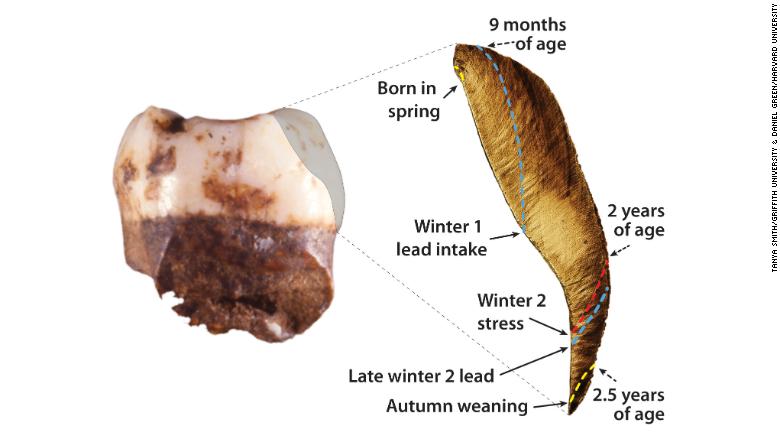
Based on an analysis of their teeth:
Two 250,000-year-old teeth from two Neanderthal children revealed that both of them were exposed to lead twice during their short lifetimes, the first known case of lead exposure in Neanderthals…
“Teeth record environmental variation based on the climate, even where you’re growing up,” said Tanya Smith, lead author of the study and associate professor at Griffith University. “That’s possible because when you’re growing, your teeth you actually lock in a record of the chemistry of the water and the food that you’re eating and drinking. Because teeth have these tiny timelines, we can relate the chemistry to the growth to calculate ancient climate records. We can’t do that with any other element of the body.”

They were able to determine that one of the Neanderthal children was born in the spring and that both children were more likely to be sick during the colder winter seasons. They lived through more extreme seasons with a greater variation in temperature than the modern human child who was also studied.Ashley Strickland, “Earliest discovery of lead exposure found in Neanderthal children” at CNN
Neanderthals were not supposed to suffer from lead exposure. Were they trying to work with lead?: Lead is a highly lustrous, bluish-white element that makes up only about 0.0013 percent of the Earth’s crust, according to the Jefferson Lab. It is not considered rare, however, since it is fairly widespread and easy to extract.
Although lead has been phased out of many of its previous uses, this non-corrosive metal is actually quite useful in products that hold or touch highly acidic substances. For example, lead is used to line tanks that hold corrosive liquids, such as sulfuric acid. It is also used in lead-acid storage batteries, such as those found in automobiles. More.
The causes of the children’s deaths are unknown but one was nursed for two and a half years.
So much more information is coming to light about Neanderthals and other vanished peoples that
it’s getting harder than ever to find the missing link. In any good Darwinian scheme, someone must be the subhuman. Otherwise, there is no beginning to human history. But stories, sure, there will be plenty more stories.
Follow UD News at Twitter!
See also: Study of baby diplodocus skull prompts new theories of dinosaur behavior Researcher: The babies most likely lived in forests in age-segregated herds, which could protect them both from predators and from being trampled by their own gigantic parents. That’s speculation of course, but the difference is that if evidence is in play, it’s no longer free-form speculation.
Soft tissue find shows dinosaurs had birdlike lungs
and
Neanderthal Man: The long-lost relative turns up again, this time with documents